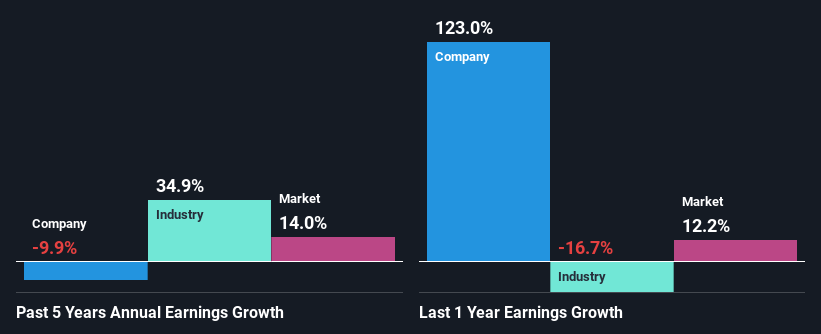Is The Market Rewarding FLSmidth & Co. A/S (CPH:FLS) With A Negative Sentiment As A Result Of Its Mixed Fundamentals?
It is hard to get excited after looking at FLSmidth's (CPH:FLS) recent performance, when its stock has declined 9.7% over the past three months. It is possible that the markets have ignored the company's differing financials and decided to lean-in to the negative sentiment. Fundamentals usually dictate market outcomes so it makes sense to study the company's financials. In this article, we decided to focus on FLSmidth's ROE.
Return on equity or ROE is a key measure used to assess how efficiently a company's management is utilizing the company's capital. In other words, it is a profitability ratio which measures the rate of return on the capital provided by the company's shareholders.
View our latest analysis for FLSmidth
How Do You Calculate Return On Equity?
ROE can be calculated by using the formula:
Return on Equity = Net Profit (from continuing operations) ÷ Shareholders' Equity
So, based on the above formula, the ROE for FLSmidth is:
6.9% = kr.763m ÷ kr.11b (Based on the trailing twelve months to March 2024).
The 'return' is the income the business earned over the last year. That means that for every DKK1 worth of shareholders' equity, the company generated DKK0.07 in profit.
What Is The Relationship Between ROE And Earnings Growth?
Thus far, we have learned that ROE measures how efficiently a company is generating its profits. We now need to evaluate how much profit the company reinvests or "retains" for future growth which then gives us an idea about the growth potential of the company. Generally speaking, other things being equal, firms with a high return on equity and profit retention, have a higher growth rate than firms that don’t share these attributes.
A Side By Side comparison of FLSmidth's Earnings Growth And 6.9% ROE
At first glance, FLSmidth's ROE doesn't look very promising. However, given that the company's ROE is similar to the average industry ROE of 5.9%, we may spare it some thought. But FLSmidth saw a five year net income decline of 9.9% over the past five years. Bear in mind, the company does have a slightly low ROE. Therefore, the decline in earnings could also be the result of this.
However, when we compared FLSmidth's growth with the industry we found that while the company's earnings have been shrinking, the industry has seen an earnings growth of 35% in the same period. This is quite worrisome.

Earnings growth is an important metric to consider when valuing a stock. It’s important for an investor to know whether the market has priced in the company's expected earnings growth (or decline). By doing so, they will have an idea if the stock is headed into clear blue waters or if swampy waters await. If you're wondering about FLSmidth's's valuation, check out this gauge of its price-to-earnings ratio, as compared to its industry.
Is FLSmidth Efficiently Re-investing Its Profits?
Looking at its three-year median payout ratio of 40% (or a retention ratio of 60%) which is pretty normal, FLSmidth's declining earnings is rather baffling as one would expect to see a fair bit of growth when a company is retaining a good portion of its profits. So there might be other factors at play here which could potentially be hampering growth. For example, the business has faced some headwinds.
In addition, FLSmidth has been paying dividends over a period of at least ten years suggesting that keeping up dividend payments is way more important to the management even if it comes at the cost of business growth. Our latest analyst data shows that the future payout ratio of the company over the next three years is expected to be approximately 48%. Regardless, the future ROE for FLSmidth is predicted to rise to 13% despite there being not much change expected in its payout ratio.
Conclusion
Overall, we have mixed feelings about FLSmidth. Even though it appears to be retaining most of its profits, given the low ROE, investors may not be benefitting from all that reinvestment after all. The low earnings growth suggests our theory correct. Having said that, looking at current analyst estimates, we found that the company's earnings growth rate is expected to see a huge improvement. To know more about the latest analysts predictions for the company, check out this visualization of analyst forecasts for the company.
New: AI Stock Screener & Alerts
Our new AI Stock Screener scans the market every day to uncover opportunities.
• Dividend Powerhouses (3%+ Yield)
• Undervalued Small Caps with Insider Buying
• High growth Tech and AI Companies
Or build your own from over 50 metrics.
Have feedback on this article? Concerned about the content? Get in touch with us directly. Alternatively, email editorial-team (at) simplywallst.com.
This article by Simply Wall St is general in nature. We provide commentary based on historical data and analyst forecasts only using an unbiased methodology and our articles are not intended to be financial advice. It does not constitute a recommendation to buy or sell any stock, and does not take account of your objectives, or your financial situation. We aim to bring you long-term focused analysis driven by fundamental data. Note that our analysis may not factor in the latest price-sensitive company announcements or qualitative material. Simply Wall St has no position in any stocks mentioned.
Have feedback on this article? Concerned about the content? Get in touch with us directly. Alternatively, email editorial-team@simplywallst.com
About CPSE:FLS
FLSmidth
Provides flowsheet technology and service solutions for the mining and cement industries in Denmark, the United States of America, Canada, Chile, Brazil, Peru, Australia, North and South America, Europe, the Middle East, Africa, and Asia.
Flawless balance sheet with solid track record.
Similar Companies
Market Insights
Community Narratives




